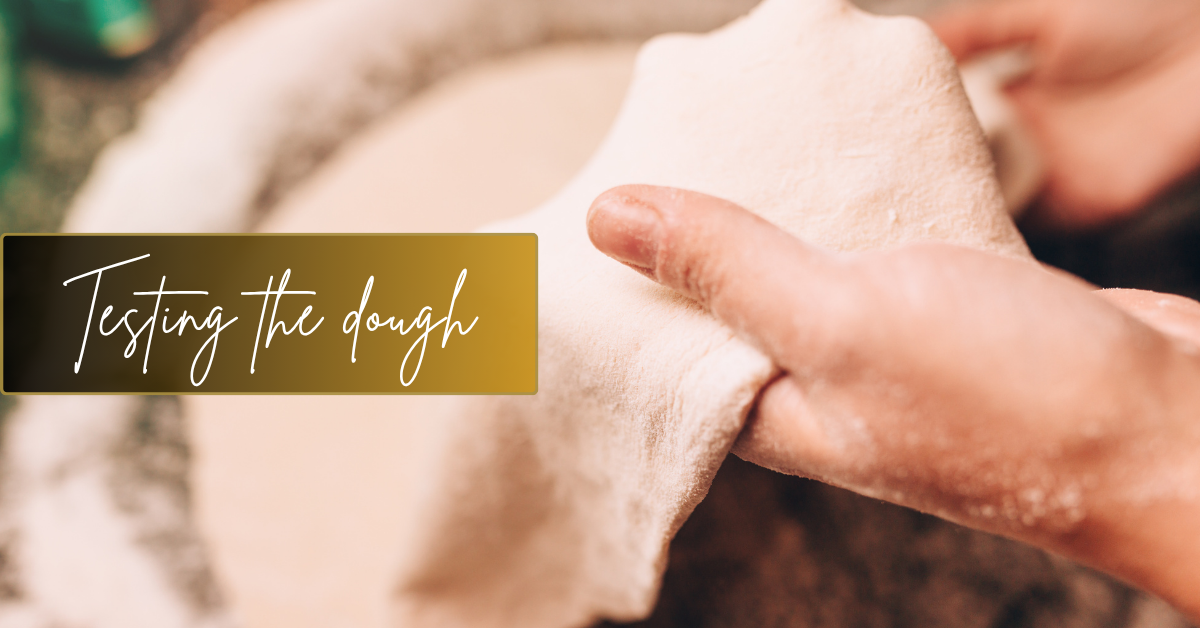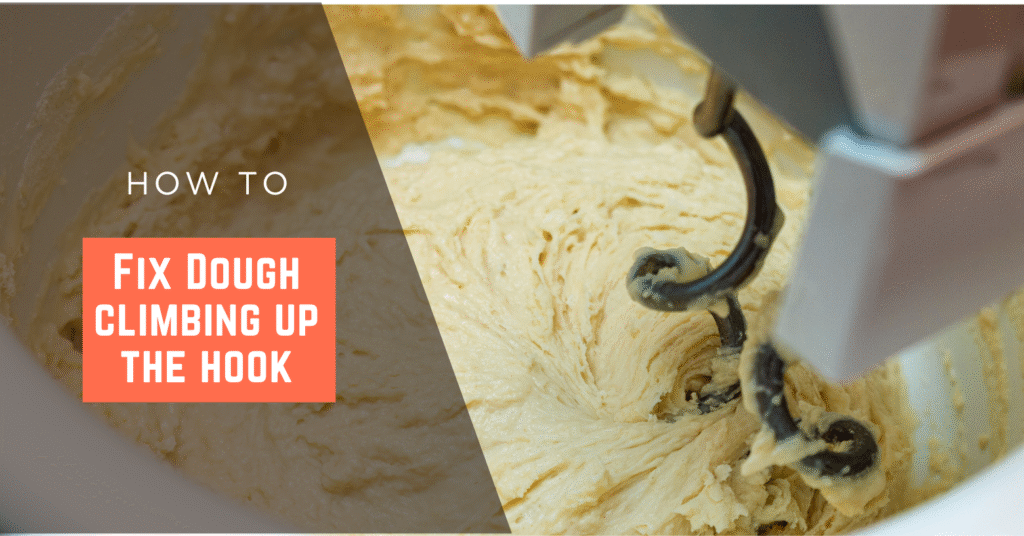Notice: I receive compensation if you buy something through affiliate links on this post. This does not change the price you would pay.
Dough climbing up the hook like it’s got somewhere to be? Annoying, right? You’re watching your mixer do its thing—and then bam. Your dough’s halfway to the motor.
You might be wondering if you missed a step somewhere, or if this is just how mixers behave sometimes. Either way, it’s a bit deflating.
The good news? There are simple ways to keep that dough where it belongs—no special gear, no wild tricks.
Let’s get into it.
Table of Contents
- 1 Why Does Dough Climb the Hook in My Stand Mixer?
- 2 Is It Normal for Dough to Ride Up the Hook?
- 3 How Should Dough Behave in a Mixer?
- 4 Is My Dough Too Dry or Too Wet If It Climbs?
- 5 How to Stop Dough from Climbing the Hook
- 6 Should I Stop the Mixer If Dough Rides Up the Hook?
- 7 Can Overkneading Cause Dough to Climb the Hook?
- 8 Bonus Tip: How to Prevent Dough from Wrapping Around the Hook
- 9 When You’re Close to Giving Up on Your Mixer
- 10 FAQs
Why Does Dough Climb the Hook in My Stand Mixer?
It starts slowly, with a little tug and a gentle wrap. Then, before you know it, your dough has spiraled its way up the hook.
This isn’t a fluke; it’s a common problem, especially when kneading heavier doughs like sandwich bread or pizza crust.
Here’s what’s going on:
- The dough is sticking more to the hook than to the bowl.
- As the hook spins, it drags the dough upward instead of stretching it downward.
- The hook’s shape—especially C-shaped hooks—can encourage this climb.
- And if the dough’s a little too dry or stiff, it grabs and holds instead of folding and kneading.
It’s a subtle thing, but it changes how your mixer interacts with the dough. What should be a smooth stretch-turn-fold motion turns into an awkward dough ride up the shaft.
Is It Normal for Dough to Ride Up the Hook?
Yes… and no.
If it happens for a few seconds, especially at the start of kneading, that’s not unusual. The dough is finding its rhythm. But if it keeps climbing? If you have to keep stopping the mixer to scrape it down every minute? That’s a problem.
It’s like the dough is refusing to cooperate. And when that happens, it’s usually trying to tell you something—either the dough’s not quite right, or the mixer needs a small adjustment.
How Should Dough Behave in a Mixer?
When things are working correctly, your dough stays low and rotates like a lazy planet around the hook. It might occasionally slap the side of the bowl or wrap loosely around the hook, but it shouldn’t ride up like it’s climbing a pole.
You’re looking for signs of healthy kneading:
- The dough pulls away cleanly from the bowl sides.
- It stretches slightly without tearing.
- It forms a smooth ball that holds together.
In my bowl-lift KitchenAid, when I mix a basic white bread dough, it usually sticks to the bottom of the bowl at first, then gradually forms a ball that hugs the hook but stays in place. When it climbs, something’s off.
Is My Dough Too Dry or Too Wet If It Climbs?
Here’s where it gets tricky, because climbing dough can come from either end of the spectrum.
If the dough is too dry, it’s stiff and doesn’t stretch well. That stiffness gives it just enough structure to grab the hook and ride up like it’s got traction.
If the dough is too wet, it gets sticky. Instead of sliding around the hook, it clings—and again, up it goes.
So which is it? Watch the texture:
- If it tears when you try to stretch it, it’s probably too dry.
- If it leaves sticky residue on your fingers and the bowl, it is too wet.
- If it’s climbing but also bouncing around in chunks: possibly both.
Try pinching a piece. If it feels tight and cracks when stretched, add a little water, just a teaspoon at a time.

So, how do you keep a stubborn dough from doing the climb? Find out how with the following easy fixes.
How to Stop Dough from Climbing the Hook
Let’s fix this. No fancy gear, no need to buy anything. Just a few simple tweaks that shift the balance back in your favor.
1. Drop the Speed
- Stick to low or low-medium speed when kneading.
- High speeds can pull the dough too fast, making it climb.
KitchenAid recommends speed 2 for kneading. It’s not just a suggestion—it does work better.
2. Let It Rest Midway
- If it’s climbing early in the knead, stop after a minute or two.
- Let the dough rest 5–10 minutes.
- Then start again.
This gives the gluten a chance to relax and rehydrate. You’ll often see the dough behave better after the break.
3. Tweak the Dough Texture
- Add a splash of water (or a pinch of flour) depending on what the dough is telling you.
- Aim for tacky but not sticky. Stretchy but not rubbery.
Tiny adjustments matter. Even one teaspoon can shift the balance between a stubborn climber and a well-behaved loaf.
4. Scrape It Down
- Pause the mixer and gently pull the dough back down into the bowl.
- Do this once or twice, and it may settle into the right rhythm.
Not elegant, but effective. Think of it as helping the mixer get back on track.
5. Watch the Bowl Size
- If you’re mixing a small batch in a large bowl, the hook can’t grab enough dough to build momentum.
- Aim for ⅓ to ½ full when kneading.
Too little dough = too much contact with the hook = the climb.
Should I Stop the Mixer If Dough Rides Up the Hook?
Yes. Stop it. Scrape it. Restart.
Letting the dough continue to climb can do more harm than you’d think:
- You risk overkneading one section while the rest gets ignored.
- You strain your mixer’s motor, especially with thick doughs.
- You lose that smooth, elastic structure that makes bread dough sing.
It’s a slight interruption, but it saves you from bigger problems down the line.
Can Overkneading Cause Dough to Climb the Hook?
It can, and often does.
When dough is overworked, it tightens up. That makes it grab the hook and pull. Instead of relaxing and folding like it should, it starts fighting back.
You’ll know it’s overkneaded if:
- It feels tough and rubbery.
- It tears instead of stretches.
- It bounces around the bowl like a pinball.
If this sounds familiar, take it as a sign to stop early next time. Less is often more when it comes to kneading.
Bonus Tip: How to Prevent Dough from Wrapping Around the Hook
Want to keep this from happening in the first place?
Try this simple rhythm:
- Mix for 30 seconds.
- Rest for 5 minutes.
- Resume kneading.
This “autolyse-style” break gives the flour time to absorb water and start gluten development naturally. By the time you knead again, the dough’s more cooperative.
One more trick:
Use a wet or lightly oiled hand to guide the dough back down early in the mix. One nudge can stop a climb before it starts.
When You’re Close to Giving Up on Your Mixer
You watch your dough spiral up the hook. Maybe you’re two seconds from shutting your mixer off and going back to hand kneading, just to prove a point.
Because when your dough misbehaves, it feels like all your effort—your measuring, your patience, your hope for a soft, fluffy loaf—is getting tangled up in that dough hook.
But now? You’ve got answers. You’ve got fixes. You’ve got insight most home bakers never get, and it didn’t cost you a thing.
You know how to spot the warning signs. You know what to do when your dough slithers up the hook. You’ll be ready. Calm. Confident.
So don’t hang up your apron just yet.
Because that moment, when your mixer kneads just right and the dough stays low in the bowl, that’s your standing ovation.

